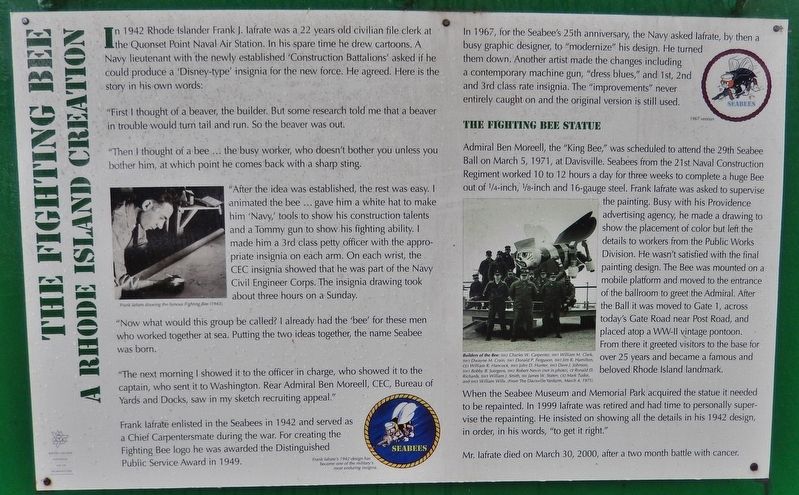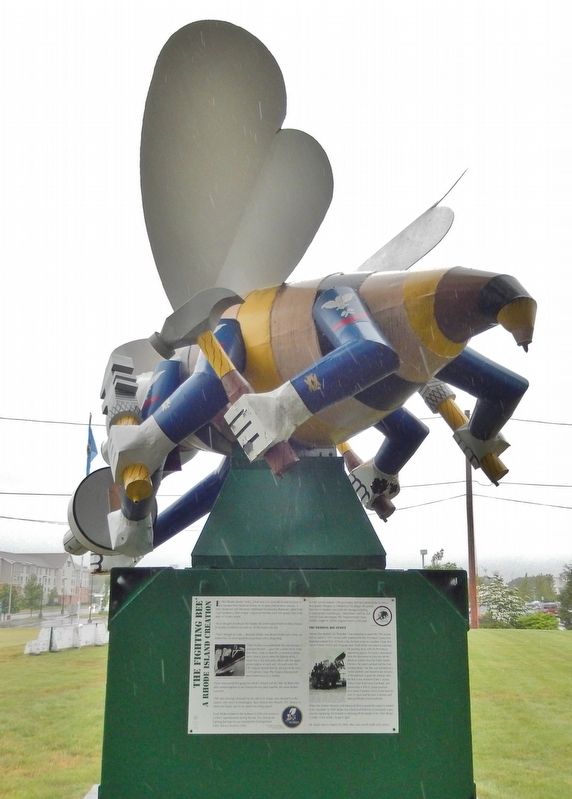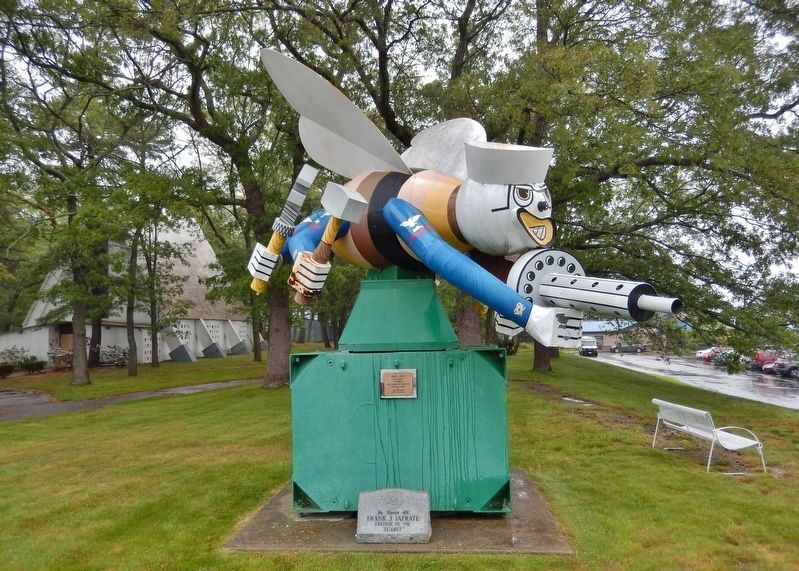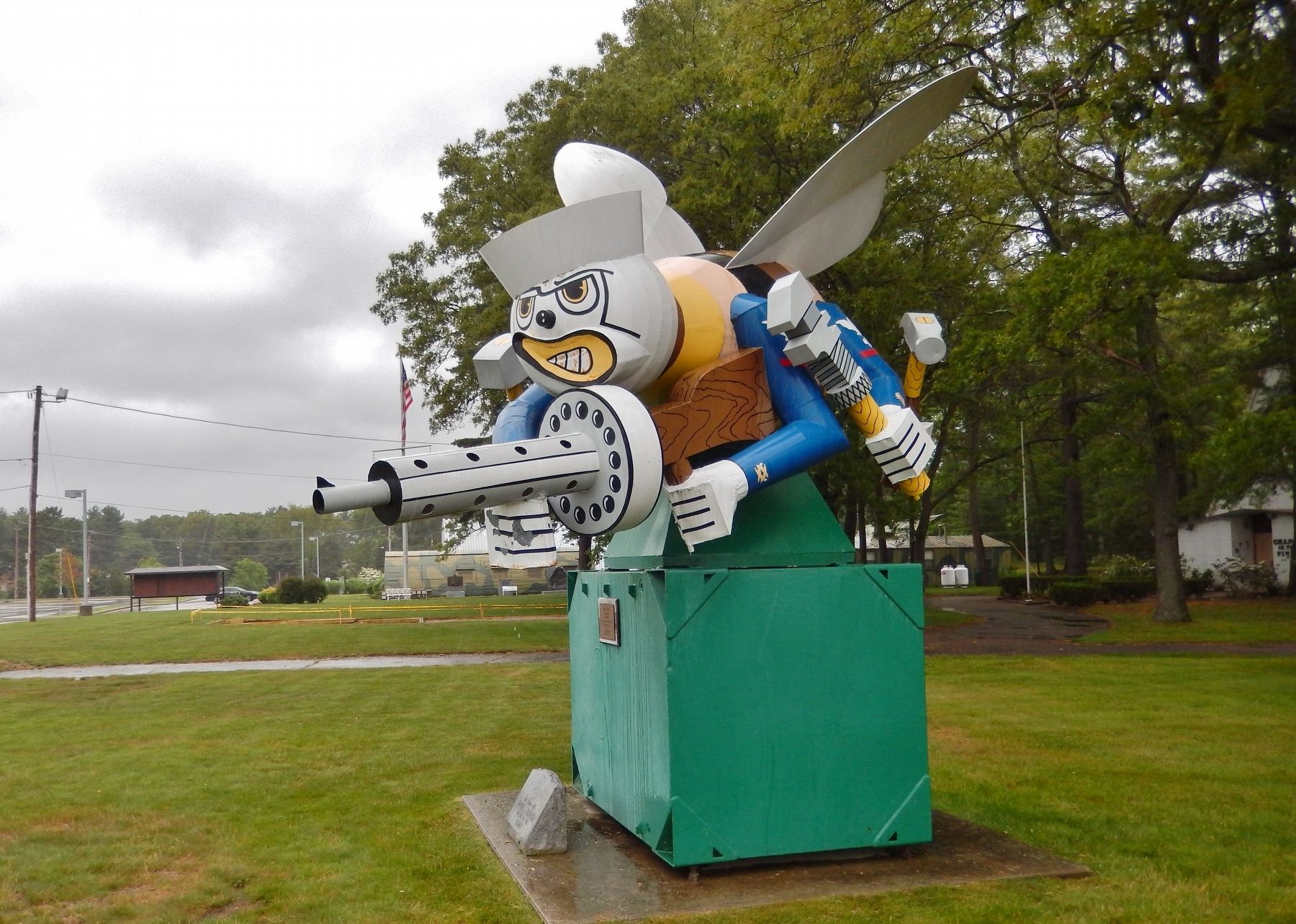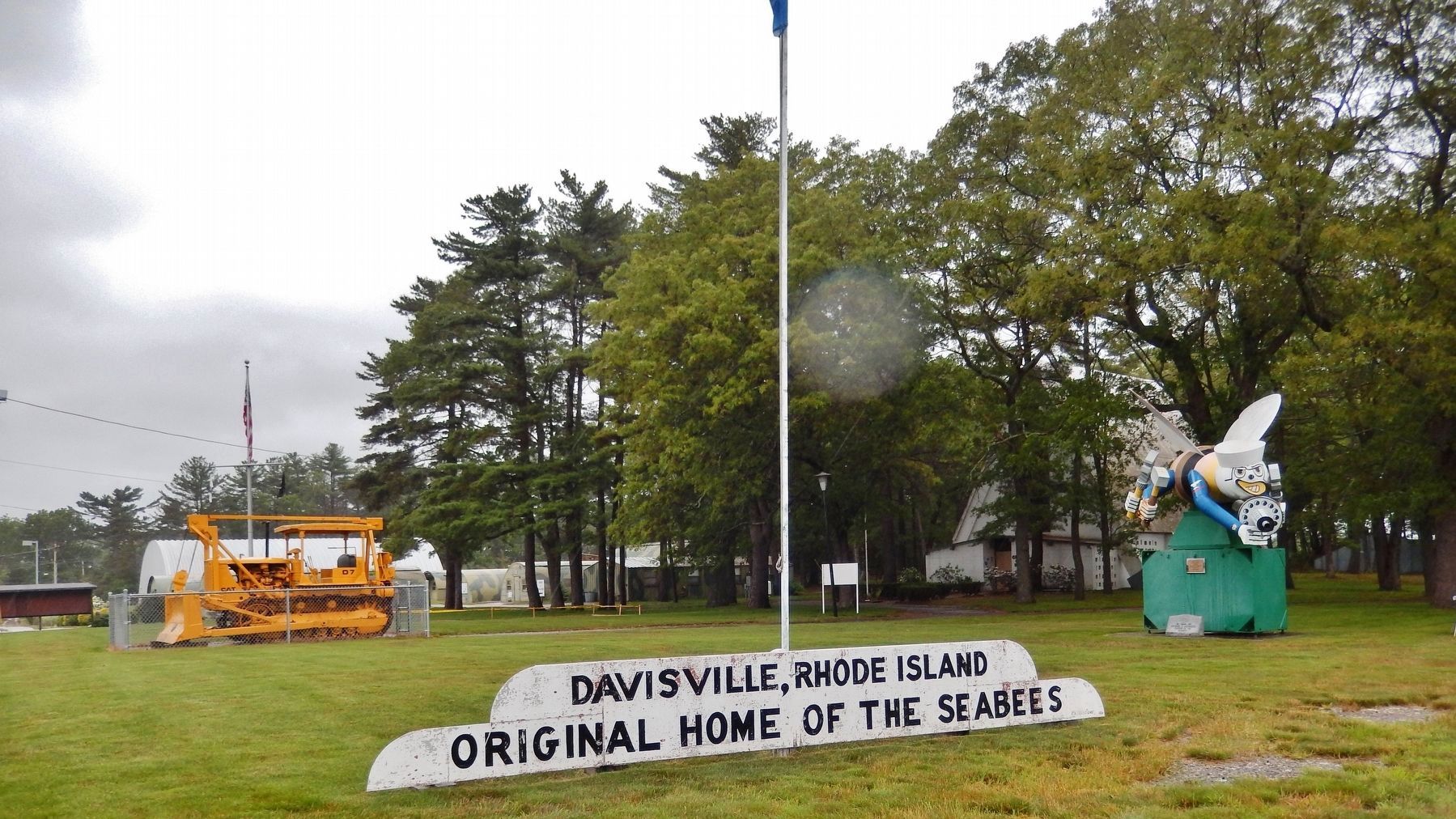North Kingstown in Washington County, Rhode Island — The American Northeast (New England)
The Fighting Bee
A Rhode Island Creation
In 1942 Rhode Islander Frank J. lafrate was a 22 year old civilian file clerk at the Quonset Point Naval Air Station. In his spare time he drew cartoons. A Navy lieutenant with the newly established 'Construction Battalions' asked if he could produce a 'Disney-type' insignia for the new force. He agreed. Here is the story in his own words:
"First I thought of a beaver, the builder. But some research told me that a beaver in trouble would turn tail and run. So the beaver was out.
"Then I thought of a bee… the busy worker, who doesn't bother you unless you bother him, at which point he comes back with a sharp sting.
"After the idea was established, the rest was easy. I animated the bee… gave him a white hat to make him 'Navy,' tools to show his construction talents and a Tommy gun to show his fighting ability. I made him a 3rd class petty officer with the appropriate insignia on each arm. On each wrist, the CEC insignia showed that he was part of the Navy Civil Engineer Corps. The insignia drawing took about three hours on a Sunday.
"Now what would this group be called? I already had the 'bee' for these men who worked together at sea. Putting the two ideas together, the name Seabee was born.
"The next morning I showed it to the officer in charge, who showed it to the captain, who sent it to Washington. Rear Admiral Ben Moreell, CEC, Bureau of Yards and Docks, saw in my sketch recruiting appeal."
Frank lafrate enlisted in the Seabees in 1942 and served as a Chief Carpentersmate during the war. For creating the Fighting Bee logo he was awarded the Distinguished Public Service Award in 1949.
Frank lalrate's 1942 design has become one of the military's most enduring insignia.
In 1967, for the Seabee's 25th anniversary, the Navy asked lafrate, by then a busy graphic designer, to "modernize" his design. He turned them down. Another artist made the changes including a contemporary machine gun, "dress blues," and 1st, 2nd and 3rd class rate insignia. The "improvements" never entirely caught on and the original version is still used.
The Fighting Bee Statue
Admiral Ben Moreell, the "King Bee," was scheduled to attend the 29th Seabee Ball on March 5, 1971, at Davisville. Seabees from the 21st Naval Construction Regiment worked 10 to 12 hours a day for three weeks to complete a huge Bee out of 1/4-inch, 1/8-inch and 16-gauge steel. Frank lafrate was asked to supervise the painting. Busy with his Providence advertising agency, he made a drawing to show the placement of color but left the details to workers from the Public Works Division. He wasn't satisfied with the final painting design. The Bee was mounted on a mobile platform and moved to the entrance of the ballroom to greet the Admiral. After the Ball it was moved to Gate 1, across today's Gate Road near Post Road, and placed atop a WW-II vintage pontoon. From there it greeted visitors to the base for over 25 years and became a famous and beloved Rhode Island landmark.
When the Seabee Museum and Memorial Park acquired the statue it needed to be repainted. In 1999 lafrate was retired and had time to personally supervise the repainting. He insisted on showing all the details in his 1942 design, in order, in his words, "to get it right."
Mr. lafrate died on March 30, 2000, after a two month battle with cancer.
Topics. This historical marker is listed in these topic lists: Arts, Letters, Music • War, World II. A significant historical year for this entry is 1942.
Location. 41° 36.388′ N, 71° 26.991′ W. Marker is in North Kingstown, Rhode Island, in Washington County. Marker is on Iafrate Way north of Gate Road, on the right when traveling north. Touch for map. Marker is at or near this postal address: 21 Iafrate Way, North Kingstown RI 02852, United States of America. Touch for directions.
Other nearby markers. At least 8 other markers are within 3 miles of this marker, measured as the crow flies. Roger Williams (approx. 1.7 miles away); North Kingstown G.A.R. Monument (approx. 2.7 miles away); Hortense Rodman Allen House (approx. 2.9 miles away); Robert Rodman's Village
(approx. 2.9 miles away); Centerpiece of the Rodman Empire (approx. 2.9 miles away); The New Mill & New Beginnings (approx. 3 miles away); A Millworker's Life (approx. 3 miles away); The Shewatuck & The Beginnings of Industry (approx. 3 miles away). Touch for a list and map of all markers in North Kingstown.
Also see . . .
1. The Origin of the Seabees.
Link to a video with the story of the origin of the Seabees, narrated by Frank J. lafrate himself. (Submitted on March 19, 2018, by Cosmos Mariner of Cape Canaveral, Florida.)
2. U.S. Navy Seabee Museum.
Link to pictures and stories of Seabees in action across many years and conflicts. (Submitted on March 19, 2018, by Cosmos Mariner of Cape Canaveral, Florida.)
3. Mascot of the Naval Construction Batallions.
The caricature of the Fighting Seabee was originally designed by Frank J. Lafrate, as a symbol of the then- newly established Naval Construction Battalions. The Fighting Seabee Statue standing guard, at the Seabee Museum and Memorial Park was erected to honor the construction officers working at sea. Holding a wrench, a hammer and a machine gun while baring it's teeth, the statue makes for an apt representation of this resilient and adept group. Although in a deteriorating condition, since last being refurbished in 1999, the Statue by itself is well worth a detour. (Submitted on March 19, 2018, by Cosmos Mariner of Cape Canaveral, Florida.)
Credits. This page was last revised on May 12, 2023. It was originally submitted on March 19, 2018, by Cosmos Mariner of Cape Canaveral, Florida. This page has been viewed 545 times since then and 107 times this year. Photos: 1, 2, 3, 4, 5. submitted on March 19, 2018, by Cosmos Mariner of Cape Canaveral, Florida. • Andrew Ruppenstein was the editor who published this page.
